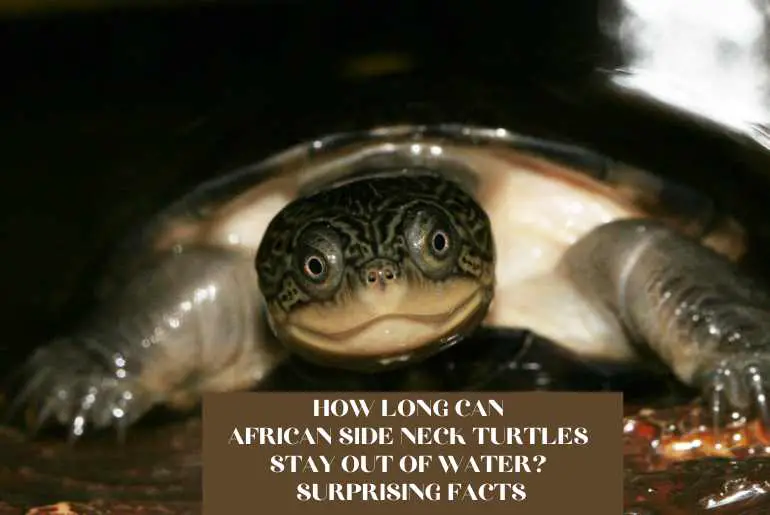African Side Neck Turtles, also known as African Helmeted Turtles or Pelomedusid Turtles, are a species of freshwater turtles found in sub-Saharan Africa. As their name suggests, their necks are positioned sideways and tucked underneath their shells rather than being pulled straight back like other turtles. How Long Can African Side Neck Turtles Stay Out Of Water?
They have a distinctive pattern on their shell, which is usually dark brown or black with yellow or white markings. African Side Neck Turtles are omnivorous and feed on a variety of plants and small animals. They are often kept as pets and require a warm, humid environment with access to both water and land. They can survive for hours or up to weeks on land.
So, how long can African side-neck turtles be out of the water, and why? Let’s find out more!
How Long Can African Side Neck Turtles Stay Out Of Water?
African Side Neck turtles can live for about a couple of hours out of the water. However, if dehydration is out of the picture, it can even go about two weeks without water too. It all depends on which period the turtle is in.
In the case of brumation and aestivation period, it can go longer without water too. It can spend up to 5 to 8 months out of the water on such occasions. How wonderful is that?
Why African Side Neck Turtle Can Survive Out of The Water?
Since the answer depends on the period, the health of the turtle, and many other factors, there is no one answer to this question.
Metabolism Rate
The African Side Neck turtles will have a cooler body temperature and moisture requirements during the period of aestivation and hibernation. This is because their metabolism rate is lower, thus need for water is low too. In such cases, the turtle can survive for more than 6 months out of water.
Season and Habitat
The season is also a reason for the turtle to decide whether or not it will survive more time out of the water. The turtles can survive for longer durations if there is a low risk of overheating and dryness.
The African Side Neck turtles live in western and central Africa. This means that they are living in the sub-Saharan climate. These turtles do not receive much rainfall and are used to the dry season for a long time.
Thus, in summer, they face a dry climate as most water sources lack water. Thus, they avoid the bone-dry climate and find ways to be close to moisture. In such cases, they cannot stay out of the water much. These turtles do not migrate much. Thus, they live near the water they can figure out.
Ways To Survive The Drought
The African Side Neck turtles burrow themselves under the soil to survive serious droughts. This assists your turtle in being cooler in the hot temperature and preserves the need for moisture to survive.
Factors That Determine How Long African Sideneck Turtle Survival Out of The Water
There are various factors that determine how long the African side-neck turtle can stay out of the water. You can study them below:
Age
The age factor determines how much drought the turtles can face. In the case of adult turtles, they can live without water much more than that of the small baby African side-neck turtle. This means that the adults are more lethargic and need less water. The adults do not dehydrate faster.
However, small baby turtles need more water as they are more active. The very reason increases the desire for them to supplement water to their bodies to get to the desired size they want to achieve.
Adults, on the other hand, enjoy basking in the sun, doing nothing!
Health
A healthy turtle can regulate its body temperature and needs less water as it is hydrated.
On the other hand, a turtle that is sick needs more water to keep its body hydrated.
Climate
The African Side Neck turtles are more acclimatized to the humid climate and do not need frequent hydration as the environment is more than enough for them.
However, the ones who are more in the drier sides of the regions might need the water and humidity to remain hydrated.
African side neck turtles absorb the famous butt breathing technique to keep the moisture of the air in their body.
In such cases, living outside water is quite easy and natural.
Time Of The Year
African Side Neck Turtles are primarily aquatic animals, and they spend the majority of their time in the water. However, they do come out of the water from time to time for basking and other activities. The time of year can be a factor in determining when and for how long they come out of the water.
In general, African Side Neck Turtles are more active and spend more time basking during the warmer months of the year when the water and air temperatures are higher. During these months, they may come out of the water for longer periods of time to regulate their body temperature, dry off, and absorb sunlight, which is essential for their health and metabolism.
On the other hand, during the cooler months, they may spend more time in the water and come out less frequently, as the water and air temperatures are lower than 44 degrees, and they need to conserve their body heat.
However, it is important to note that the specific behavior of an African Side Neck Turtle can vary depending on factors such as its individual preferences, the availability of basking spots, and its overall health and well-being.
How Long Can Baby African Side Neck Turtles Be Out Of Water?
Baby African Sideneck Turtles, like adult turtles, are aquatic animals and need to spend most of their time in the water. However, they occasionally come out of the water to bask, explore their surroundings, and breathe fresh air.
The length of time that a baby African Sideneck Turtle can stay out of water depends on various factors, such as the age, size, and health of the turtle, as well as the temperature and humidity of its environment. In general, it is recommended that baby African Sideneck Turtles should not be kept out of the water for more than 30 minutes at a time, especially if they are very young and small.
It is important to provide baby African Sideneck Turtles with a warm, humid environment with access to both water and land, so they can regulate their body temperature, stay hydrated, and get the exercise they need to develop and grow properly. Additionally, it is important to monitor their behavior and health closely and provide them with proper nutrition and care to ensure they thrive.
You might also be interested in:
How Long Can Yellow-Bellied Turtles Stay Out Of Water?
How To Tell If An African Side Neck Turtle Is Dehydrated?
Dehydration is a serious concern for African Sideneck Turtles, and it can lead to various health problems if not addressed promptly. Here are some signs to look for to determine if an African Sideneck Turtle is dehydrated:
Sunken Eyes
Dehydration can cause a turtle’s eyes to appear sunken or dull. The turtle’s eyes look deep-seated if they are more dehydrated.
Dry Skin
A dehydrated turtle may have dry, flaky, or wrinkled skin, especially around its neck and limbs.
Lethargy
A dehydrated turtle may be less active and show less interest in its surroundings.
The African side-neck turtle becomes listless when dehydrated. It won’t move much at all, even if its limbs or neck are prodded.
However, take note that elderly turtles used to their owners’ contact will exhibit comparable symptoms as well.
Dehydrated turtles will only rest in one location and will not be interested in swimming or foraging.
Loss of Appetite
Dehydration can cause a loss of appetite or make a turtle less interested in eating.
Water makes up a sizable portion of a turtle’s body weight. Additionally, a dehydrated African side neck turtle loses significant body weight.
By assuming the weight of the turtle when handling it, you can tell a healthy turtle from a dehydrated one. One of the first indications of dehydration in turtles is weight loss.
Regularly check the turtle’s weight to make sure you don’t miss any unusual changes.
Thick Urates
Dehydration can lead to concentrated urine, which may result in thick, chalky-looking urates.
Foul-Smelling Breath
Dehydration can cause a turtle’s breath to have a strong, unpleasant odor.
Wrinkled Skin
Keep an eye out for wrinkly skin on the body of your African side-neck turtle. Pinching the animal’s skin will reveal whether or not it is moisturized. The skin should slip back to its usual position right away. Otherwise, the turtle is dehydrated.
If you notice any of these signs in your African Sideneck Turtle, it is important to take immediate action to rehydrate it. You can offer your turtle fresh, clean water to drink and provide it with a shallow water dish or a larger swimming area with clean water to soak in.
Additionally, you can mist its enclosure with water to increase humidity and help it absorb moisture through its skin. If your turtle’s condition does not improve, you should seek advice from a reptile veterinarian.
Why Is My African Sideneck Trying To Come Out Of Tank Too Often?
African Sideneck Turtles are aquatic animals, and they spend most of their time in the water. However, they occasionally come out of the water to bask, explore their surroundings, and breathe fresh air. If your African Sideneck Turtle is trying to come out of its tank too often, it could be a sign that something is wrong. Here are some possible reasons why your turtle may be behaving this way:
Water Quality
Poor water quality can make a turtle uncomfortable and encourage it to leave the water. If the water in the tank is dirty, has a strong odor, or is not at the right temperature, your turtle may try to escape.
Lack of Basking Area
African Sideneck Turtles need a basking area to regulate their body temperature, dry off, and absorb sunlight. If your turtle’s tank does not have a suitable basking area, it may try to come out of the water more often.
Inadequate Lighting
Adequate lighting is crucial for a turtle’s health and well-being. If your turtle is not getting enough light, it may become restless and try to escape.
Overcrowding
If the tank is too small or has too many turtles in it, your turtle may feel stressed and try to escape.
Illness or Injury
If your turtle is sick or injured, it may try to come out of the water more often. Signs of illness or injury may include lethargy, lack of appetite, and other unusual behaviors.
If you are concerned about your turtle’s behavior, it is important to investigate the possible causes and address any issues promptly. Providing a clean, well-maintained environment, a suitable basking area, adequate lighting, and proper care can help keep your African Sideneck Turtle healthy and content.
What Happens To An African Sideneck Turtle’s Body When Out Of Water?
When African Sideneck Turtles are out of the water, their bodies undergo a number of changes as they adapt to their new environment. Here are a few things that happen to an African Sideneck Turtle’s body when it’s out of the water:
Breathing
Unlike fish, turtles are air-breathing animals, meaning they need to come to the water’s surface to breathe. When they are out of the water, they can breathe air directly through their lungs, just like humans do.
Skin Drying
When an African Sideneck Turtle is out of the water, its skin will start to dry out. To avoid dehydration, it’s important to provide your turtle with a humid environment and to mist its skin regularly.
Temperature Regulation
African Sideneck Turtles are cold-blooded animals, which means they rely on external heat sources to regulate their body temperature. When they are out of the water, they may use basking areas, heat lamps, or other sources of warmth to keep their bodies at a comfortable temperature.
Mobility
African Sideneck Turtles are slower and less mobile on land than they are in the water. When they are out of the water, they may move more slowly and awkwardly and may have difficulty navigating certain obstacles.
When Can African Sideneck Turtles Go Up To Months Without Water?
African Sideneck Turtles are aquatic turtles, and they rely on water to regulate their body temperature, stay hydrated, and get oxygen. While they can go for several days without water, they cannot go for months without it.
You may be confusing the African Sideneck Turtle with another turtle or tortoise species that is more adapted to arid environments and can go for long periods without water. For example, some species of desert tortoise have adaptations that allow them to survive in very dry environments and go for several months without drinking water.
However, African Sideneck Turtles are not adapted to survive in arid environments and require regular access to clean, fresh water to stay healthy. If an African Sideneck Turtle is deprived of water for an extended period, it can become dehydrated, leading to serious health problems and even death.
Only in case of hibernation and aestivation can the African side neck turtle go without water for a long duration of up to 8 months.
Final Words
African Sideneck Turtles are aquatic animals and should be provided with an appropriate aquatic habitat that allows them to swim, bask, and regulate their body temperature. While they can come out of the water for short periods to bask or explore their surroundings, they should not be kept out of the water for extended periods.
If African Sideneck Turtles are kept out of water for too long, they can become dehydrated, which can lead to serious health problems and even death. It’s important to make sure that your turtle has access to clean, fresh water at all times and that its habitat is properly maintained to ensure that it is healthy and happy.
If you have any concerns about your African Sideneck Turtle’s health or behavior, it’s a good idea to consult with a veterinarian who specializes in reptile care. They can help you identify and address any issues affecting your turtle’s health and well-being.
You might also be interested in the following topics:






